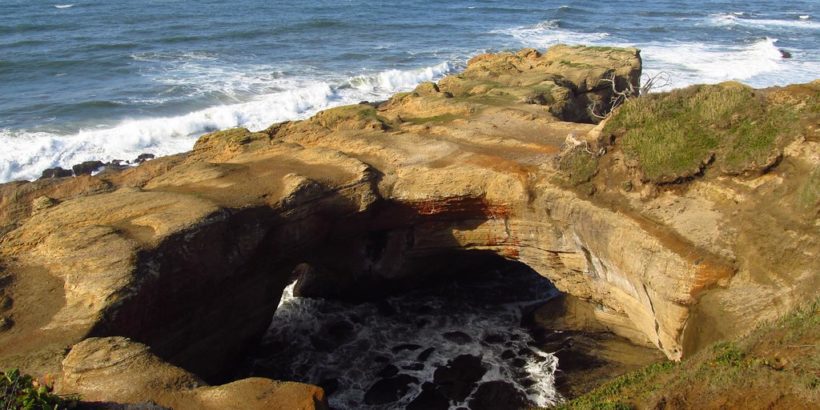Oregon has some of the nicest beaches that you’ll find in the country. Many of these beaches like Cannon Beach are very popular but there also are some destinations that are not as well-known. In this article, I will highlight four stunning beaches/locations along the Oregon coast that you won’t want to check out.
Related: Ultimate Guide to Cleaning Seashells
Table of Contents
Thor’s Well at Siuslaw National Forest (Cape Perpetua, Oregon)
- Admission: $5 fee
- Hours: Visitor center, 10 a.m. to 4 p.m. daily (fall schedule)
- Pets: Allowed but not recommended near sneaker-wave-prone shores
Thor’s Well, sometimes referred to as the “Pacific Gateway to the Underworld,” is one of the most exhilarating seascapes along the West Coast of the United States. During high tide or when the surf is raging from incoming Pacific storms, waves wash into a large hole, estimated to be around twenty feet deep, creating one of nature’s most intriguing sites: a natural fountain that spews salt water several yards into the air and then sucks the water back down into its depths, creating a spectacular, and sometimes eerie, natural wonder.
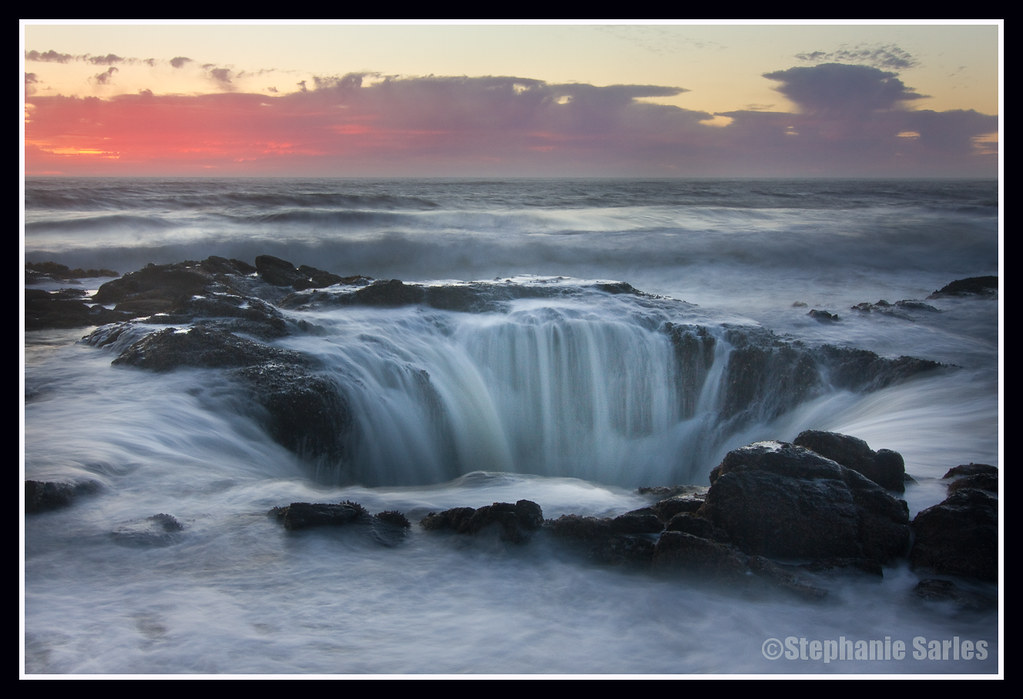
The key to experiencing this wonder and getting the best photographs is catching Thor’s Well at high tide, usually about an hour before and after will do. If you catch it around low tide, Thor’s Well may look nothing more than like a mere hole in a bunch of rocks.
In fact, at low tide you’d probably walk by Thor’s Well unless you knew exactly where to look. However, if you’re willing to brave potentially hazardous conditions at high tide, it’s unlikely that you’ll miss it, especially because you might notice a photographer or two already positioning themselves for a shot at this amazing natural spectacle.
For those willing to venture into the Thor’s Well site during peak tidal conditions, the risks involved cannot be overemphasized. It’s a beautiful yet dangerous attraction. Due to the tumultuous flow of the crashing waves and water, it’s unlikely that anyone could make their way out of the hole alive in the event they were swept in.
Short of getting swept in, the biggest danger is probably just slipping on your way to and from the well site, an additional danger to yourself (and your camera) that you should not underestimate. The jagged and slippery rocks one has to navigate to get near the site can become death traps in an instant due to huge “sneaker waves” or “sleeper waves” that often wash up and cover the rocks without warning.
One thing to keep in mind is that you’ll likely get battered with ocean spray as you stand near Thor’s Well. Some photographers bring mist shields or rain covers for their cameras and also equip themselves with water-resistant coats and pants. Some even go as far as wearing booties to protect their feet, and that’s probably not a bad idea.
The cold Pacific water, combined with harsh winds and perhaps even wintry conditions, can make it tough to remain patient for the right shot. Because this site requires you to master the proper timing to capture the “waterfall effect” seen above, it’s a good idea to stay as dry and comfortable as possible.
Thor’s Well can be reached from the Cape Perpetua Scenic Area visitor’s center parking lot. From there you’ll access a short trail that will lead you down to the rocky shores. As stated, you’ll need to pay close attention to where you are stepping and keep a close eye on sneaker waves, all while trying not to lose sight of Thor’s Well.
If you’re going to check out Thor’s Well, then you might also consider stopping by Devil’s Churn, another fascinating site only about a mile north of Thor’s Well. Devil’s Churn, also located in the Siuslaw National Forest, is a narrow inlet where thousands of years of thrashing wave activity has carved a narrow passageway into the basalt shoreline.
During times of high tide, the surging tide roars through this tight passageway and crashes into the rocks, casting ocean spray one hundred feet or more into the air at times, leaving spectators marveling at both the beauty and violent forces of nature.
Unlike Thor’s Well, you can actually see Devil’s Churn from the parking lot at the Cape Perpetua Scenic Area visitor’s center; although, if you prefer a closer look at this amazing feat, you can embark on the short .4-mile Restless Waters Trail.
As with Thor’s Well, you’ve got to exercise a lot of caution when venturing down the rocks to get a close-up view of the churning waters. When rogue waves roll through Devil’s Churn, their force is so powerful and amplified that the waves can easily sneak up on you and wash you, your pets, and/or your camera off the rocks.
Devils Punch Bowl State Natural Area (Lincoln County, Oregon)
- Admission: Free
- Hours: 24/7 access
- Pets: Allowed but must be leashed at all times
From an overlook you admire a beautiful bowl carved naturally into the rock headlands. The placid green waters that ebb and flow below you are in stark contrast to the tempestuous conditions that will arrive with the tide in just a few short hours. When high tide finally rolls in, waves smash into this giant cauldron, spewing sea foam as they churn and swirl in a spectacular display of nature’s violent side. It’s a spectacle, for sure, and when pounding Pacific storm systems move in, it’s utter chaos.
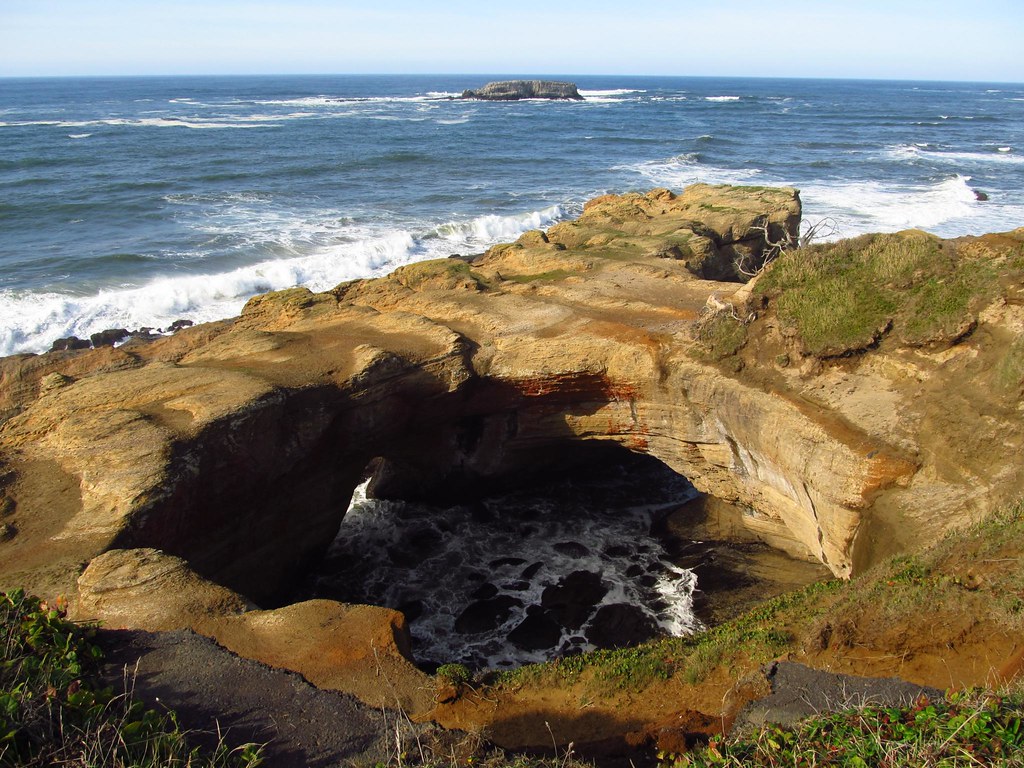
But it’s not just the turbulent waters that draw visitors here to this Oregon Natural Area. Many visitors head down the short Devils Punch Bowl Trail at low tide to explore the interior of this giant cauldron. Along the way to the Punch Bowl, there are also dramatic carvings in the cliffs and even a few small sea caves for you to explore.
It’s best if you wait beyond low tide for an actual negative tide, as those conditions will provide you with the most opportune and certainly the safest conditions for exploring inside Devils Punch Bowl. Be sure to time your visit with peak low-tide conditions since there would be little-to-no chance of anyone making their way out of Devils Punch Bowl alive if they were to get stuck during dangerous high-tide conditions.
If you do happen to make it to Devils Punch Bowl during low tide, then you absolutely have to check out the wondrous tide pools in the area. Some of the most diverse marine specimens in the world can be found along the Oregon coast with tide pools that seemingly go on for miles and miles on end. This destination is well-known among locals, so expect some crowds on weekends and during other peak visiting times. At all other times, though, the crowds should be thinned out.
Tips
- The cliffs here are exceptional for gray whale watching with posts that offer sensational panoramic views of the Pacific Ocean.
- The squirrels here are known for being exceptionally social. Many of them will approach guests who are feeding them nuts.
Sea Lion Caves (Florence, Oregon)
- Admission: Free to $14, depending on age
- Hours: 9 a.m. to 4 p.m. daily, except for Christmas Day
- Pets: Not allowed on tours, but okay on leash in visitor center area
Visitors, standing mere feet apart, struggle to hear each other over loud barks echoing through the shadowy caverns. The source of these barks? About two hundred rowdy sea lions. The fascinating home to these marine mammals, known as Sea Lion Caves, is a system of caverns along the Oregon coast that make up what many estimate to be the largest sea cave in North America, measuring nearly two acres with ceilings that tower 120 feet above the water. While the cave and its inhabitants are definitely a natural wonder to behold, opinions vary on the experience offered at Sea Lions Caves.
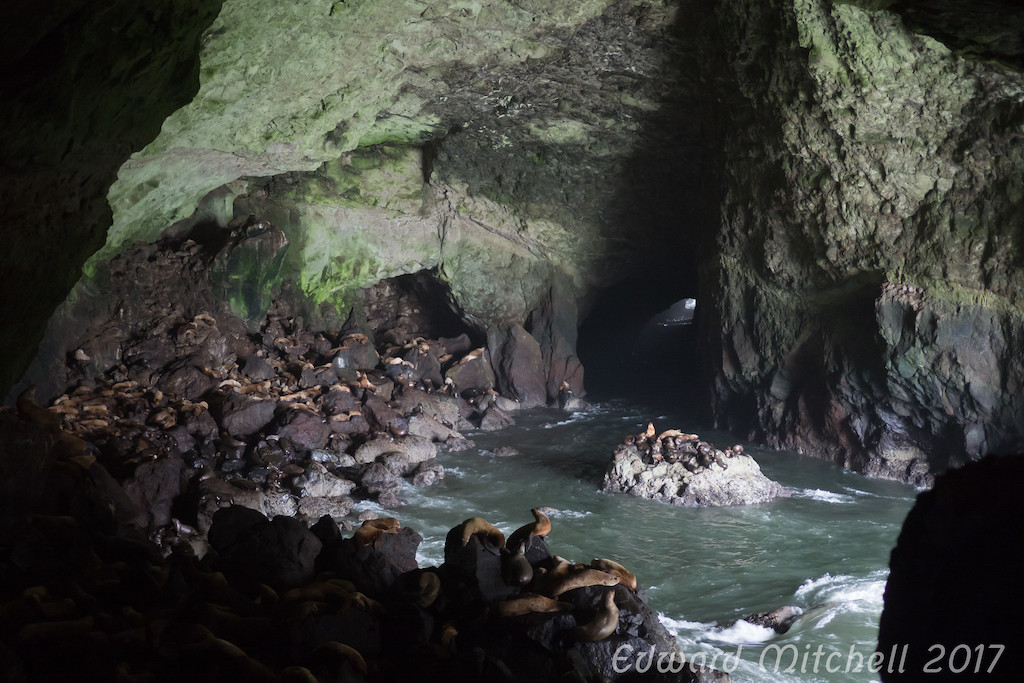
The sea lions inhabiting this cave are known as stellar sea lions and are the largest of the eared-seal family. Although capable of hunting 15 miles offshore and diving to depths of over 1,300 feet, they usually forage near the shores, often at night, in search of a wide variety of fish, such as cod, salmon, and capelin, though they are also known to feed on bivalves and even squid and octopus. They are colonial breeders and adult males, called bulls, will sometimes go up to two months without eating while they devote all their energy to aggressively defending their territory.
Many confuse these marine mammals with other sea lions and seals, but there are some key differences. Stellar sea lions differ from California sea lions in that they are lighter and much larger, with males growing up to 11 feet long and weighing almost 2,500 pounds compared to a length of 8 feet and a maximum weight of 1,200 pounds for the California sea lion.
As for the seal comparison, stellar sea lions differ from seals in a number of ways, but one of the most noticeable differences is that stellar sea lions are capable of walking on shore by flipping their hind flippers forward as opposed to seals who merely wiggle along the shore on their bellies.
As mentioned, this place receives a mixture of praise and dissatisfaction from its visitors. For critics, the biggest drawback to Sea Lions Caves are the high admission prices and what some view as the overcommercialization of such a beautiful site along the great Oregon coast.
The $14 fee per adult is simply too much for some, and the perception of too much commercialization is not an entirely unfair assessment. I agree with that criticism to the extent that I prefer the open (and free) areas of the Oregon coastline where seals and sea lions can often be spotted. And at $14 per adult, you might expect at least a museum on-site (though the gift shop has gotten great reviews, and there are a few interesting exhibits to check out).
Aside from that mostly negative point of view, Sea Lions Caves is still a natural wonder that offers the unique experience of riding down an elevator into a habitat of sea lions inside one of the largest sea caves on the entire continent. And despite the commercialized tone of the place, the cavern is still a completely natural habitat formed out of basalt rock over twenty-five million years ago.
So if you’re the kind of traveler who doesn’t mind shelling out a little bit of cash for a unique attraction which you can then check off your bucket list, you’ll probably appreciate the experience. Otherwise, if you’re the type who tends to shy away from anything even remotely resembling tourist traps, then you may want to stick to exploring other parts of the Oregon coast.
The biggest word of advice I can offer for those interested in Sea Lions Caves is to not bother visiting during the summer because the sea lions themselves are nowhere to be found that time of the year. It’s only during the balance of the year (best in December) that you are more likely to actually spot sea lions in the caves.
The business is nice enough to offer a rain check (good for one year) and a reduced price of $12 if you don’t see any sea lions, but you still may not want to waste your time by showing up when no sea lions are in sight. If you’re concerned about this, then just call ahead and ask the staff members at the front desk if there are any seals currently in the cave.
And one last thing about the cave: get ready to hold your nose. It stinks. The huge population of sea lions in the area give off a very pungent odor that can be a little shocking to the senses. So prepare yourself for that. Visitors report that the scent hits them as soon as they step foot in the elevator, so, if you’re not forewarned, it can be a very jarring and unpleasant experience.
The good news, however, is that, above the caves, there’s an overlook of the ocean where you can get all the fresh air you need and which is also a great spot for watching the migrating gray whales that are visible virtually year-round. And, if you’re lucky, you may even catch a glimpse of an orca. In addition the surrounding sea cliffs are a sight worth visiting by themselves, not to mention seeing an impressive lighthouse that gets great reviews.
If you’re planning on taking photographs of the sea lions, you might struggle a bit since the lighting conditions in the cave are pretty tough to work with. Users with high-end DSLRs that work well under low-light conditions will have an easier time, especially if they choose to work with multiple exposures. However, standard point-and-shoot or cell phone cameras will likely have a tough time in the dark caves where flash is not allowed, so keep that in mind.
Lost Boy Beach (Oceanside, Oregon)
- Admission: Free
- Hours: Open 24/7, weather and tide conditions permitting
- Pets: Allowed
Located off the Three Capes Scenic Drive in northern Oregon, Oceanside is a small and quiet beach town nestled in a beautiful amphitheater-shaped hillside along the Oregon coast. The town is home to the Oceanside Beach State Recreation Site, which is a prime destination for beachgoers and those looking to explore some hidden beach caves and coves. During negative tides, a series of caves can be explored that give access to private and secluded beaches. And the best part of all is that it’s free.
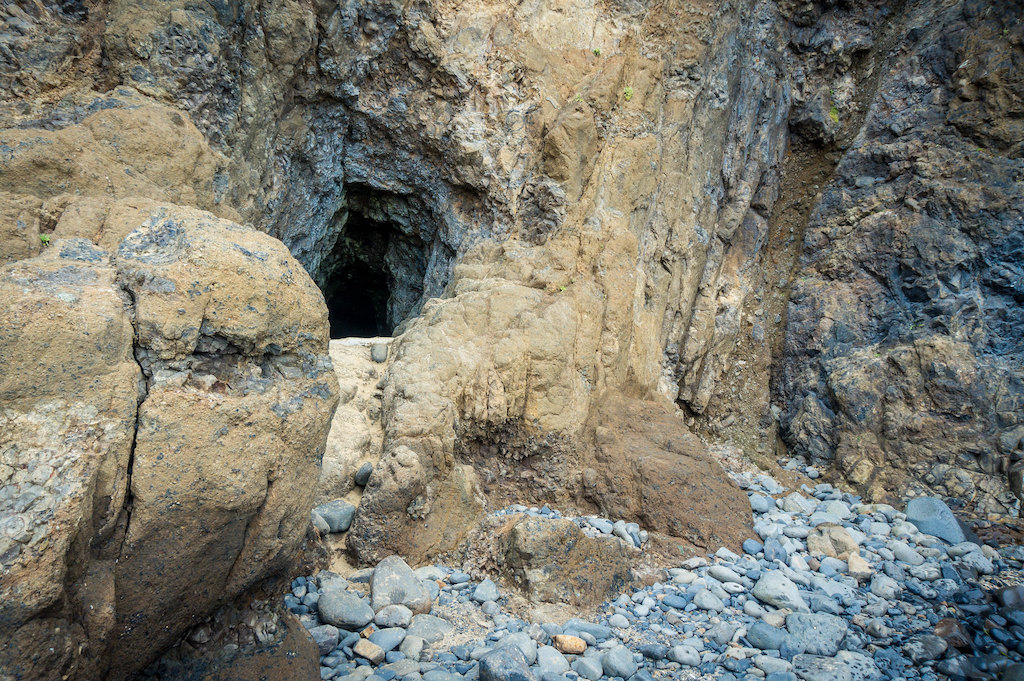
At the northernmost tip of the beach is Maxwell Point, which is a giant sea cliff with a tunnel that, during low tide, you can walk through to reach a hidden beach known as Tunnel Beach. Travel farther north on Tunnel Beach, and you’ll come to a cliff that can only be passed during a negative tide and will lead you to yet another secluded and perfectly idyllic spot known as Agate Beach.
Continuing north, you’ll arrive at the famous Lost Boy Cave. It’s said that the cave got its name from two boys who ventured down through the cave and got stranded for almost an entire day as the rising tide prevented them from getting out. Whether or not that’s how the cave earned its name, there’s no doubt that the story serves as a reminder about the high degree of awareness you need to have when venturing in the area. The beauty of this place is mind-boggling, but visitors must be mindful of the risks involved with these coastal areas.
Once you enter Lost Boy Cave, it actually forks into two portals that lead you to Short Beach, also called Lost Boy Beach. All of the coves and beaches are beautiful and are surrounded by stunning sea stacks that strike different poses along the horizon and create brilliant foregrounds for sunset photographs.
The caves and secluded beaches do offer an exciting day of exploration, but you must properly plan your trip according to the tide schedules and only access this beach when there’s a negative tide (at least -2 is recommended). Otherwise, you run the risk of being stranded on one of the beaches and finding yourself featured as the main character in your own Lost Boy Cave tale.
But it’s not just the tides that you have to keep an eye out for. Extensive rain showers over the years have brought mudslides to the cliffs which have buried some of the cave entrances. If there has been a lot of rainfall preceding the days of your visit, you may want to check with the local park staff about the potential for mudslides.
If you do the right planning and take the right kind of precautions with this destination, you’ll likely be one of only a few people exploring the entire area and enjoying an unrivaled peaceful and solitary outdoor experience. And don’t forget to plan some time for tide-pooling and “agate hunting.”
The beaches here offer an array of tide pool sites to explore, and, during the winter months, these beaches are a fantastic place for hunting agate stones, which are beautiful, sometimes translucent forms of silica rock containing bright and colorful bands. These agate stones are a beach collector’s dream, and they are best discovered after harsh storms, when winds and strong tides have uncovered them from the sand.
There’s more to this area than the caves and hidden beaches. Just a few miles north is the Cape Meares Lighthouse Scenic Viewpoint that’s full of interesting things to see. The lighthouse itself (rumored to be haunted) is an interesting attraction that’s open daily from April to October from 11 a.m. to 4 p.m. and is free to visit.
Also all around the lighthouse area are amazing lookout points for whale and bird-watching. It’s also not uncommon to spot paragliders soaring in the sky above Three Arch Rocks. Perhaps the biggest two attractions in the lighthouse area are the Big Spruce and the Octopus Tree.
The Big Spruce is Oregon’s largest Sitka spruce tree, standing 144 feet tall and 48 feet in circumference; it’s estimated to be 750 to 800 years old. The Octopus Tree, once featured on Ripley’s Believe It or Not, is one of the strangest trees in the country. It’s a Sitka spruce tree measuring 46 feet in circumference and is over 105 feet tall.
While massive, it’s the unique tentacle-like limbs that grow as if an upside-down octopus that set this tree apart from any other tree you’ll come across. Nobody is quite sure how these candelabra limbs took their shape. It’s possible that the strong winds over the past couple hundred years resulted in the odd assembly of tall limbs, but some speculate that Native Americans played a role in its formation. It was not uncommon for tribes, such as the Tillamook, to designate such trees as scared ceremonial sites and to “train” the trees to grow into odd forms.
Both the Big Spruce and the Octopus Tree are accessed via short trails within walking distance (a couple hundred yards) of the Cape Meares Lighthouse.
Tips
- Stop by the renowned Roseanna’s Café for a great meal while in the area.
- There’s a path that leads to Short Beach from the Three Capes Highway, but check with local officials to make sure that the trail is maintained enough for you to venture on at the time of your visit.
Daniel Gillaspia is the Founder of UponArriving.com and the credit card app, WalletFlo. He is a former attorney turned travel expert covering destinations along with TSA, airline, and hotel policies. Since 2014, his content has been featured in publications such as National Geographic, Smithsonian Magazine, and CNBC. Read my bio.

